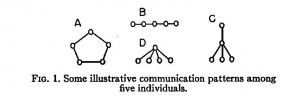Network experiment in coordination games
Paper Cited: Bavelas, A. (1950). Communication patterns in task-oriented groups. Journal of the acoustical society of America.
Link: http://scitation.aip.org/docserver/fulltext/asa/journal/jasa/22/6/1.1906679.pdf?expires=1445203617&id=id&accname=2098200&checksum=78C47231BE7D0E666B8364B16DD9EBFF
Network experiments emerged as early as in the 1950s, when some MIT psychologists started to explore how network structure affects groups’ efficiency in problem solving. Bavelas provided a seminal design of such experiments. In his design, each individual receives a card showing different symbols. Individuals in a group have only one symbol in common and the problem is to find out what that common symbol is. Group structures are exogenously imposed, meaning that information can only flow along the edges designated by the authors. Individuals in the experiment communicate by passing written messages to their designated partners. In this paper, four different communication network structures are imposed: (1) the chain, (2) the circle, (3) the star, and (4) the “Y” (Figure below).
The author finds that groups with the star or the “Y” structures are most efficient in solving problems. This is demonstrated by the fact that they exchange least number of messages while making the fewest errors. Another interesting part of the experiment is that each individual is asked to report his or her degree of satisfaction after the experiment. The authors find that individuals in the circle and the chain report highest average satisfaction during the experiment. Only the individual that acts as the center in the star reports higher satisfaction.
This paper relates to the concepts of “power” and “structural balance” that we learned recently in class. The fact that individuals at the center of the networks report higher satisfaction confirms the linkage between outside choices and power (individuals at the center of the star or the Y are more powerful than individuals in circles or chains, while other individuals in the star or the Y are weaker). In fact the design of Bavelas’ experiment itself resembles the network exchange experiments we learned in class where participants communicate according to a pre-designated social network structure. Moreover, the experiment is also relevant to the “coordination game” we have learned in the game theory module in class. The ability of each group to solve the problem with least messages exchanged in essence measures the efficiency of convergence to a Nash equilibrium in a dynamic (repeated) coordination game. Thus I find this paper very interesting in the sense that it combines game theory with network topology and empirically tested its hypothesis with experiments.
